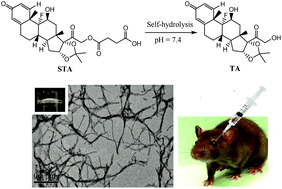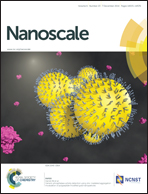Supramolecular nanofibers of triamcinolone acetonide for uveitis therapy†
Abstract
Supramolecular nanofibers of prodrugs hold advantages for drug release due to their high drug payload, sustained and constant drug release behavior, and stimuli responsiveness. In this study, we report on a supramolecular hydrogel mainly formed by a clinically used drug triamcinolone acetonide (TA). Such a hydrogel could only be prepared via an ester bond hydrolysis process from its prodrug of succinated triamcinolone acetonide (STA). The resulting hydrogel could constantly release TA in the in vitro release experiment. The TA hydrogel possessed an excellent transscleral penetration ability, as evaluated by the in vitro transscleral transport study. The developed TA hydrogel also exhibited a great ocular compatibility in rats, as indicated by the optical coherence tomography (OCT) images, HE observation, and glial fibrillary acidic protein (GFAP) and vimentin immuno-staining assays of the retinas. Our TA hydrogel showed a decreased efficacy to inhibit ocular inflammation in the rat's experiment autoimmune uveitis (EAU) model compared to the commercial TA suspension (Transton®), but without causing complications such as high intraocular pressure and cataracts. These promising properties of the hydrogel indicated its great potential for the treatment of eye diseases.


 Please wait while we load your content...
Please wait while we load your content...